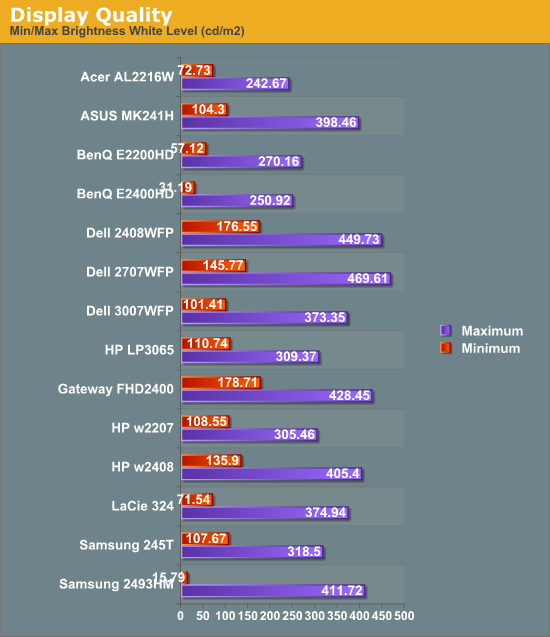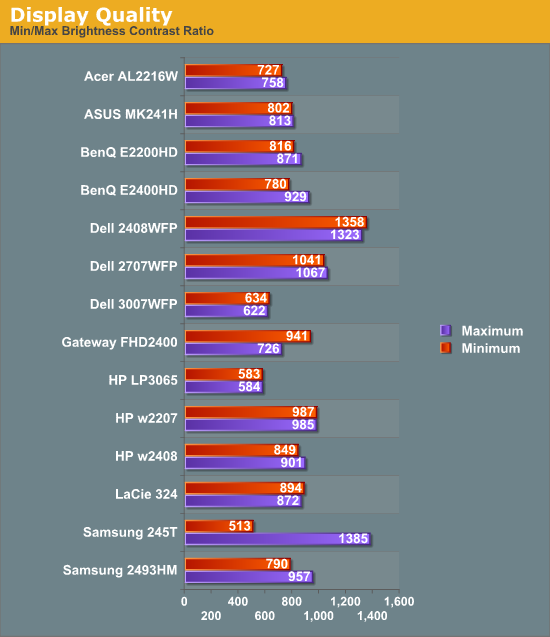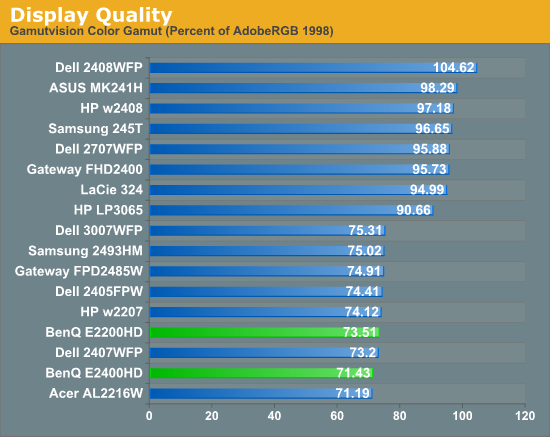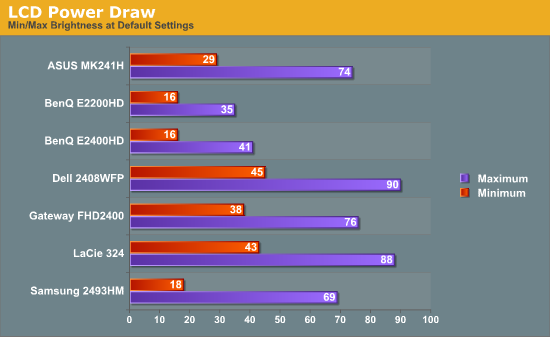BenQ E2200HD and E2400HD - 1080P FullHD LCDs
by Jarred Walton on November 4, 2008 5:00 AM EST- Posted in
- Displays
Brightness and Contrast Ratio
For the brightness (luminance), contrast, and color accuracy tests, we depend on a hardware colorimeter and software to help calibrate the displays. We use a Monaco Optix XR (DTP-94) colorimeter and Monaco Optix XR Pro software, and we also test with ColorEyes Display Pro. Results in nearly every case have been better with Monaco Optix XR Pro, so we only report the ColorEyes Display Pro results on the monitor evaluation pages. We'll start with a look at the range of brightness and contrast at the default LCD settings while changing just the brightness level. (In some cases, it will be necessary to reduce the color levels if you want to achieve a more reasonable brightness setting of 100-120 nits.)



The two BenQ LCDs have a maximum brightness level of 250-270 nits, which is more than sufficient and is actually brighter than what most users prefer to use in an office environment. If you want to reach the advertised 300 nits brightness setting, you will need to adjust contrast and/or color levels as well. Minimum brightness at default settings is 30-50 nits, so there's typically no need to fiddle with color levels.
More important than the luminosity is the contrast ratio that is achievable at the various brightness settings. Depending on setting, we measured a contrast ratio of 780~930 with these LCDs. While higher scores are better, in reality anything above 700 is more than sufficient for most users. The Dell 2408WFP tops our charts, but this is mostly a victory of marketing numbers. Also, we wouldn't worry about any advertised dynamic contrast ratio numbers -- at least not if you want consistent colors.
Color Gamut
We've already shown color gamut for the LCDs, but here's a chart showing how the LCDs stack up against each other. We use Gamutvision, a utility developed by Imatest LLC to calculate color gamut. We compare the color profiles of the LCDs to the Adobe RGB 1998 color profile and report the results as a percentage.

So far, color gamut has generally fallen into one of two categories: either +/-95% or +/-75%. The BenQ E2200HD and E2400HD target the budget market, so it's not too surprising that color gamut is lower than many competing models. However, it's important to keep things in perspective: these results may seem very low, but if you are using the standard sRGB profile (Windows' default) these LCDs look fine. It's only in applications like Adobe Photoshop with its improved color space that you begin to notice a difference between the displays.
Power Requirements
We also look at power requirements, but we've changed our testing procedure somewhat since previous article. Minimum power requirements are going to depend largely on how dim the backlight is at the minimum setting, so a display that only puts out 16 nits at minimum brightness should logically use less power than one that puts out 50 nits. Since very few people will run an LCD at less than 100 nits, we tested at that level, as well as our standard 200 nits that we use for calibration, and finally at maximum brightness setting using default color and contrast settings. Since we changed testing procedures, we don't have equivalent information for any other LCDs yet, so we included a chart showing min/max power draw as well (our previous power test). We will report the new results in a table, along with brightness and contrast ratio information at the various settings.

| Power, Brightness, and Contrast Levels | ||
| BenQ E2200HD | BenQ E2200HD | |
| Maximum Power Draw | 36W | 41W |
| Maximum White | 270.16 | 250.92 |
| Maximum Black | 0.31 | 0.27 |
| Maximum Contrast | 871 | 929 |
| Calibrated Power Draw | 29W (66%) | 34W (73%) |
| Calibrated White | 199.3 | 199.23 |
| Calibrated Black | 0.23 | 0.22 |
| Calibrated Contrast | 867 | 906 |
| Print Power Draw | 20W (20%) | 24W (30%) |
| Print White | 100.03 | 99.34 |
| Print Black | 0.11 | 0.11 |
| Print Contrast | 909 | 903 |
Looking at just the two BenQ LCDs, it's no surprise that the larger E2400HD consumes slightly more power. Perhaps more interesting is that many old 20" CRTs could draw 100W or more and only attain a brightness level of ~120 nits. That's one more reason we prefer LCDs (along with a lot less strain on our backs when moving displays around). Even at maximum brightness, the BenQ displays both use less power than the other LCDs we've tested, but those displays may have been brighter so we can't make any definite conclusions about "greenness".










33 Comments
View All Comments
10e - Wednesday, November 5, 2008 - link
If the last MVA panel from BenQ/AUO is any indicator, input lag should be low. I had the FP241VW with December 2007 firmware and it was 7.9ms behind a CRT, with only 5% of the time it being 2 frames behind. The other times it was only 1 frame behind, or none at all.It's good to see that our crying over on another forum has kept BenQ and AUO from abandoning the non-TN market altogether
The only tiny issue with it was dark greys shifted more than (say) my Dell 2709W (S-PVA). Good luck with the review.
Jorgerr - Tuesday, November 4, 2008 - link
Did you check the Samsung T220P? looks that have the same specs as the Benq. Seems to be a very interesting competitor as well.I would appreciate to read your comments about it.
JarredWalton - Tuesday, November 4, 2008 - link
Looks like that was an Asian release only? I'm not sure... spec-wise, it's actually a 1920x1200 LCD, and I haven't seen any of those in 22" trim over here in the US. Weird. Honestly, I wouldn't be surprised if Samsung makes the panel in the BenQ LCDs; then again, it's either Samsung, AU Optronics, or Chi-Mei so I have a 33% chance of guessing right. ;-)Jorgerr - Tuesday, November 4, 2008 - link
Thanks :-) In Israel the Samsung T220P is available, and we belongs to Asia.Good luck with the new president! No matter who will be I wish you the best.
NARC4457 - Tuesday, November 4, 2008 - link
[quote]We are only aware of one other 22" LCD manufacturer that offers native 1080P support (ViewSonic), and we feel this is an untapped market.[/quote]Check out Dell's new 2209W, it is a Full HD 22" LCD
http://accessories.us.dell.com/sna/products/Displa...">http://accessories.us.dell.com/sna/prod...mp;dgc=C...
JarredWalton - Tuesday, November 4, 2008 - link
I edited the conclusion for you - I should have known better than to make an assumption without a bit more research. Probably HP has a similar display too - or it's in the works. Obviously, where one LCD company goes plenty will follow, and if there aren't more 22" 1080P LCDs right now I expect that to change. The Dell 2209W appears to lack HDMI input, however, so that's a big advantage for the BenQ and ViewSonic options IMO.NARC4457 - Wednesday, November 5, 2008 - link
True enough, I was surprised that they didn't have the same amount of inputs that many of their existing monitors already have.Wasn't looking for an update to the article, just wanted to send it your way in case you were looking for more monitors to review. :) Thanks jared, good information in the review.
strikeback03 - Wednesday, November 5, 2008 - link
Probably all use the same LCD panel - once the panel becomes available, the usual suspects will all build a display around it.Flyboy27 - Tuesday, November 4, 2008 - link
I know I want to step up to 1920x1200 or 1920x1080 so that means a 24" monitor. They seem to be the sweet spot right now as you can get a video card these days to run those resolutions in almost every game for a very reasonable price. However, there's no reason for me to upgrade my HD3850 until I get a bigger monitor since it runs all games just fine at 1440x900. I'm sure there are many other folks out there that are in the same boat.Now, it's easy to figure out comparatively which video card to get by reading Anandtech and other such sites but harder to find info on 24" monitors. Not too hard to compare FPS in a certain resolution and find a video card to get the best bang for your buck. However, for a guy that is a gamer, movie watcher, internet browser, and avid Photoshop user what monitor is the best bang for the buck. I don't want to sacrifice panel speed for colors. My idea with colors and Photoshop is just get me "close enough" and I'll be happy. I'm also on a budget (that's why I'm not looking at 30" monitors). Where is the happy medium here guys? -Thanks
JarredWalton - Tuesday, November 4, 2008 - link
I have a BenQ MVA panel up next for review, along with a couple other 24" LCDs. I'm going to be very interested to see if the MVA panel can offer colors and viewing angles equal to S-PVA but with processing lag equal to S-IPS/TN. Stay tuned....